Jun 24, 2014 | ANES, Elections, National
Post developed by Katie Brown and Spencer Piston.
The 2008 election in the United States featured the first black major party presidential candidate in U.S. history – Barack Obama. Obama won in a historic election. But was his victory margin narrower than it could have been? In particular, did racial prejudice erode Obama’s vote share among those whites expected to vote for him: strong Democrats?

Photo credit: Thinkstock
Center for Political Studies (CPS) affiliate and Ph.D. Candidate in Political Science at the University of Michigan Spencer Piston explored this question with co-author Yanna Krupnikov (Northwestern University) in a recent article published in Political Behavior.
The researchers identify a gap in the field. Where previous work focuses on the connection between prejudice and vote choice, few studies have considered the relationship between prejudice and turnout on Election Day.
The researchers evaluate the relationship between racial prejudice, strength of party identification, and turnout. They are especially interested in a situation in which a white voter, high in racial prejudice, is faced with a black candidate from her party. How will the voter vote? In this scenario, racial prejudice is pitted against party identification.
Examining 2008 data from the American National Election Studies and replicating their analyses with survey data from a wave of a 2007-2008 Associated Press-Yahoo! News-Stanford University study, the authors find that highly partisan and prejudiced voters often address the tension embodied in a black candidate from their party by not turning out to vote. Interestingly, the authors also test if this group would instead vote for the white Republican presidential candidate John McCain. They would not. This is because they cannot compromise on race or partisanship. Unable to compromise, they instead choose not to vote.

These findings have significant implications for American elections. The authors conclude, “Racial prejudice undermines black candidates’ efforts to mobilize strong partisans.”
Spencer Piston will join Syracuse University in the fall as an Assistant Professor of Political Science.
Jun 18, 2014 | Foreign Affairs, International
Post developed by Katie Brown and Michael Traugott, with input from Ghaydaa Yehia Fahim Ali.
In 2008, Qatar University formed a partnership with the University of Michigan‘s Institute for Social Research (ISR) and Center for Political Studies (CPS) to develop a world-class public opinion research organization at Qatar University, the Social And Economic Survey Research Institute (SESRI). The partnership includes, among other activities, collaboration on organizational structure, recruitment and hiring, design of technical facilities, research, and analysis. As part of the cooperation, University of Michigan researchers also run training workshops in Qatar several times per year. Participants for the workshops come not only from Qatar University, but other private and public organizations from Qatar and throughout the Gulf region. Topics for the workshops have included research design, questionnaire design, cognitive interviewing, data analysis, and sampling. The workshops are structured as lectures, with group exercises integrated into the flow. Between days, participants complete thought exercises to spur discussion the next day.
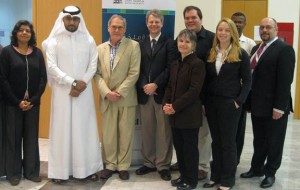
Photograph from first training workshop of 2014
This year, SESRI hosted three workshops. In the first workshop, which was delivered by ISR researchers Nancy Burns, Ted Brader, Kenneth Coleman, Allen Hicken, and Ashley Jardina, trainees were introduced to key SPSS concepts and notions of hypothesis design and formulation. Causal inferences and random sampling were key areas of discussion.

Traugott and Lepkowski shake hands with a workshop participant at “commencement”
Michael Traugott of CPS and James Lepkowski of ISR’s Survey Research Center (SRC) traveled to Qatar to administer the second workshop, a course on sampling and weighting methods and techniques. Arriving Friday, the team took the weekend to adjust to the eight-hour time change and set up for the training. Monday through Thursday, sessions ran from 9:00 a.m. to 2:00 p.m., with a break in the middle for lunch and prayers.
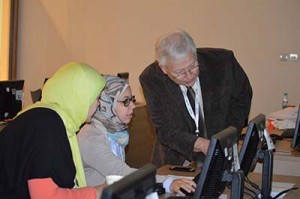
Lepkowski interacts with workshop participants
Materials from sampling courses previously taught by Lepkowski were adapted with consideration of language and culture. Courses are taught in English with an Arabic translator on hand, while all materials are available in both languages. Technical terms associated with social science concepts and principles were provided in a glossary, in which some terms were accompanied by animations created by Rafael Nishimura to illustrate the ideas with video. Furthermore, all exercises were designed to be completed in Excel for reasons of accessibility. At the end of the course, Excel spreadsheets with key formulas were provided to all participants.
Traugott returned in May, along with Elizabeth Gerber, Ann Lin, and Monica Bhatt to facilitate a workshop on policy evaluation and spur debate on the purpose of evaluation in public policy, the primary components of policy and program evaluation, and methods of designing preliminary, defensible program evaluations. Workshop materials were tailored to ensure local relevance, including the identification of public policy issues in the cases of Qatar’s traffic woes and evaluations of changes to the education system in Qatar.
The workshop series has caught the attention of the Qatari press. The Qatar Tribune wrote that “The trainees who came from backgrounds in statistics and other diverse fields found the workshops to be useful in introducing them to concepts outside their direct frame of work.”
More than 100 beginner and intermediate-level researchers benefited from the workshops this year, which continue to grow in popularity. More information about the workshops can be found here.
Jun 11, 2014 | International, Social Policy
Post by Rosemary Sarri.
This post was written by Center for Political Studies, School of Social Work and Women’s Studies Professor Emerita Rosemary Sarri, after her visit to the Philippines in the spring of 2014.
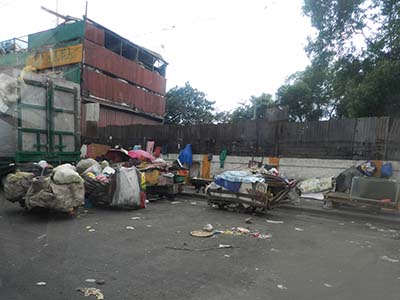
Manila slum from a car window
The island country of the Philippines is the 12th most populous country in the world with a growth rate of 1.89% per year. The population skyrocketed from just 26,272,000 people in 1960 to 98,734,000 people in 2014, a growth rate of 254%. Tremendous cost has accompanied this explosive growth. Most of the population live below the poverty line and reside in urban or metropolitan areas which are extremely crowded. The slums of Manila have become almost inhuman places in which to reside. Because the land prevents the creation of a subway system, the country primarily relies on motor vehicles for transportation, creating terrible pollution that tripled in recent years.
Recently, some local non-profit organizations have organized efforts to foster community development. One of these organizations is Gawad Kalinga, established by a small group of benefactors to work with the people of the slums to provide them with land, food, and housing.
I visited one of their projects in Cavite Province, located a short distance from Manila. They emphasize the restoration of community empowerment and training for gainful employment and active citizenship. Gawad Kalinga gives priority to dismantling the pattern of despair and abandonment that overwhelms the lives of the very impoverished.
Gawad Kalinga believes moving people out of the slums is essential to eradicating poverty. The project that I visited in Cavite provides brightly painted single or duplex housing for about 45 families with a community center, health center, an informal education center and a grocery store. The residents learn to care for their own facilities. Overall the community survey indicated that they received good health care and education for their children. Employment of the men in nearby communities is strongly encouraged, but many, especially women, wanted more assistance in obtaining employment.
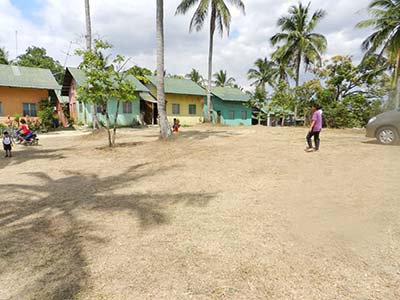
Buildings of Gawad Kalinga
While Gawad Kalinga is making strides in the right direction, birth control and family planning are issues that probably deserve more attention. Families in the community have a median of three children. And over-population is a country-wide problem. The strong influence of the Catholic Church since its colonization by Spain resulted in strong opposition to most methods of contraception or birth control. In 2012, this influence started to wane as the government began to address over-population with the passage of the Responsible Parenthood and Reproductive Health Act. Yet, a recent community survey by the Philippine School of Social Work at The Philippine Women’s University indicates that 69% of Filipinos rely on “natural methods” of family planning or abstinence. Despite a national campaign for vasectomy, few Filipinos opted for the procedure.
Gawad Kalinga embodies the Philippines’ overpopulation problems, both as a solution to the inhuman living conditions of Manila’s slums, a partial answer to unemployment woes, and an underscoring of the country’s population problem.
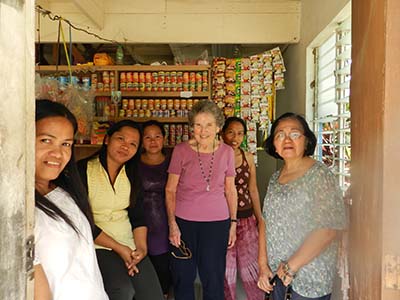
Sarri with some of the women residents of Gawad Kalinga
Jun 9, 2014 | ANES, ANES 65th Anniversary, National
Post developed by Katie Brown and Deborah Schildkraut.
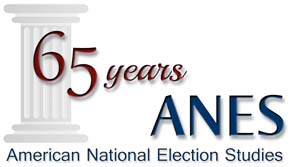 This post is part of a series celebrating the 65th anniversary of the American National Election Studies (ANES). The posts will seek to highlight some of the many ways in which the ANES has benefited scholarship, the public, and the advancement of science. Do you have ideas for additional posts? Please contact us by email ([email protected]) or Twitter (@umisrcps).
This post is part of a series celebrating the 65th anniversary of the American National Election Studies (ANES). The posts will seek to highlight some of the many ways in which the ANES has benefited scholarship, the public, and the advancement of science. Do you have ideas for additional posts? Please contact us by email ([email protected]) or Twitter (@umisrcps).
In this post, we consider the impact of ANES on teaching.
First, we hear from Tufts University Professor of Political Science Deborah Schildkraut, who shares her experience using ANES in the classroom. From Schildkraut:
ANES impacts my teaching in two key ways. First, I use raw ANES data in my lectures.Second, the research I rely on as I teach and that I think is really meaningful for my students includes:
All take advantage of the time series to help demonstrate both the importance of fundamentals and the role of particular events in shaping attitudes, behaviors, and election outcomes. And all are written at a level that combines sophisticated methods but approachability such that undergrads can engage with them.
Second, in a 1977 grant proposal to the American National Science Foundation (NSF), ANES founder Warren Miller outlined the current and potential use of ANES in teaching. This excerpt from the proposal encapsulates his analysis and vision:
The election data are even more widely used in activities related to teaching. Reports from the same roster of political scientists who were questioned about research use of the data indicate that the data were being used for teaching purposes in some 480 courses taken by more than 18,000 students… Given the reasonably short history of the systematic use of quantitative data by political science students in meeting course requirements, we were surprised to discover that three-quarters of the students using the data were actually undergraduates.
The hand typed table below from the 1977 proposal details the use of ANES (then called the Michigan Election Study) in the university classroom.
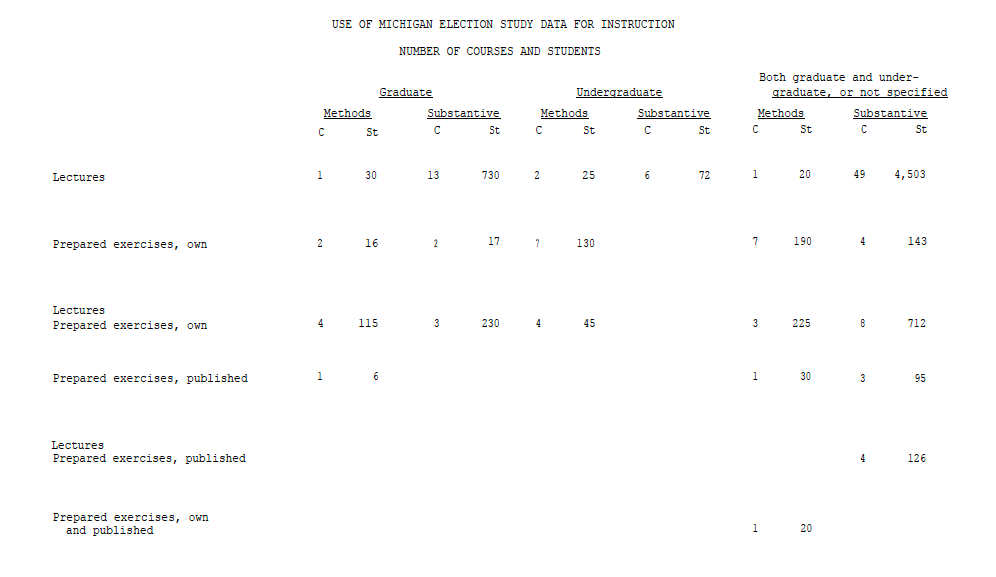
Miller then concluded, “The election studies promise to play an increasingly significant role in undergraduate teaching.” Professor Deborah Schildkraut’s use of ANES nearly forty years after the 1977 proposal demonstrates the continued reach of ANES in the classroom.
Jun 4, 2014 | Innovative Methodology, International
Post developed by Arun Agrawal and Katie Brown.
Are our efforts to measure changes in conservation by talking to decision makers effective?

Photo credit: Thinkstock
This question motivated recent research by Arun Agrawal, Center for Political Studies (CPS) faculty associate and Professor in the School of Natural Resources and the Environment (SNRE) at the University of Michigan.
An article by Christoph Nolte, Agrawal, and Paulo Barreto that appears in Environmental Research Letters considers the effectiveness of a globally used assessment strategy that is referred to as Rapid Assessment and Prioritization of Protected Area Management (RAPPAM).
Utilized in over 50 countries, RAPPAM is the most popular tool to determine environmental protection. RAPPAM aims to measure whether a protected area is achieving its conservation goals. This ,in turn, influences the allocation of resources (financial, personnel, equipment, and otherwise). Despite its popularity, its empirical effectiveness had yet to be demonstrated. So Nolte, Agrawal, and Barreto conducted their study to see if RAPPAM’s measurements are indeed effective. The research team analyzed data on 66 protected areas in the Brazilian Amazon.
The results? RAPPAM appears ineffective.
Specifically, there is no correlation between RAPPAM’s indicators and avoided deforestation. These null results highlight the need to invest in new, better, and more valid measurements. Such measurements should not be based just on subjective assessments by those who are paid to manage protected areas.
Sound simple? It still hasn’t happened! Good decision tools may not be enough to make conservation work. Nolte, Agrawal, and Barreto argue that without such tools, it is even less likely to work.












